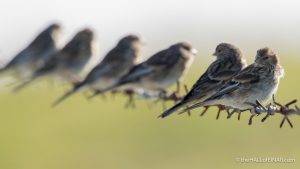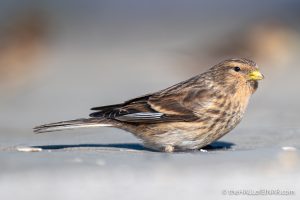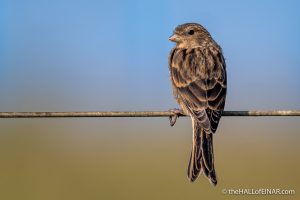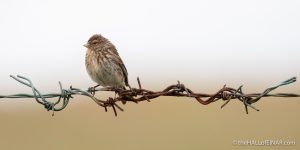The death of the Yellow-Billed Linen-Weaver
The scientific name of the Twite is Linaria flavirostris. Linaria means linen-weaver and flavirostris means yellow-billed. Twite are Yellow-Billed Linen-Weavers. They’re also on the brink of extirpation in England, despite desperate heroics to save them by the RSPB, working with Natural England.
It’s Twite Week here at the Hall of Einar. Aren’t they lovely?

There are 10 or 11 recognised subspecies of Twite. Being a series of islands, which always helps the formation of new species, Britain and Ireland are on the list:
- L. f. bensonorum (Meinertzhagen, R, 1934) – Outer Hebrides (western Scotland) (sometimes included in pipilans)
- L. f. pipilans (Latham, 1787) – northern Ireland and northern Britain.
- L. f. flavirostris (Linnaeus, 1758) – northern Scandinavia and northwestern Russia.
- L. f. brevirostris (Bonaparte, 1855) – Turkey, the Caucasus and northern Iran.
- L. f. kirghizorum (Sushkin, 1925) – northern and central Kazakhstan.
- L. f. korejevi (Zarudny & Harms, 1914) – northeastern Kazakhstan to northwestern China.
- L. f. altaica (Sushkin, 1925) – southwestern Siberia, northern and western Mongolia.
- L. f. montanella (Hume, 1873) – Kyrgyzstan to western China.
- L. f. pamirensis (Zarudny & Harms, 1914) – Tajikistan, northern Afghanistan and northwestern Pakistan(sometimes included in montanella).
- L. f. miniakensis (Jacobi, A, 1923) – eastern Tibet and western China.
- L. f. rufostrigata (Walton, 1905) – western and southern Tibet, northern India and northern Nepal.
There were just 12 nests in England in 2021. Here are the details of the RSPB’s valiant attempt to save them:
https://www.rspb.org.uk/our-work/conservation/projects/england-twite-recovery-project/
What will we do with all our money when the natural world is dead? (asking for a Twite).

Read more about Twite
 Twite There's a Pennine Finch on barbed wire. That's a cue for me to lift my lens up: Lovely, aren't they? read more
Twite There's a Pennine Finch on barbed wire. That's a cue for me to lift my lens up: Lovely, aren't they? read more A flock of Twite and an inside leg measurement I'm walking one of the sections of coastal path on Westray. At least a path is what I call it.… read more
A flock of Twite and an inside leg measurement I'm walking one of the sections of coastal path on Westray. At least a path is what I call it.… read more A Heather Lintie at the Castle o’ Burrian Twite are such beautiful birds. Their subtlety is exceptional, with the softness of their stripes and the paleness of their… read more
A Heather Lintie at the Castle o’ Burrian Twite are such beautiful birds. Their subtlety is exceptional, with the softness of their stripes and the paleness of their… read more Two little Twite, sitting on a wall I've spent this week honouring Twite, a wonderful, curious, much-overlooked bird. Twite live in weedy fields and moorland, or at… read more
Two little Twite, sitting on a wall I've spent this week honouring Twite, a wonderful, curious, much-overlooked bird. Twite live in weedy fields and moorland, or at… read more Step on Watching Twite is a delight. Every time one jumps, the others bob up and down, too. We've been photographing a… read more
Step on Watching Twite is a delight. Every time one jumps, the others bob up and down, too. We've been photographing a… read more Can you imagine the Pennines without the Pennine Finch? Twite are on the verge of extirpation in England. Their last stand is in the 'Twite Triangle' between Manchester, Leeds… read more
Can you imagine the Pennines without the Pennine Finch? Twite are on the verge of extirpation in England. Their last stand is in the 'Twite Triangle' between Manchester, Leeds… read more A small brown bird which few people care about Welcome to Twite Week at The Hall of Einar. Twite are small brown birds. To the uninitiated they might look… read more
A small brown bird which few people care about Welcome to Twite Week at The Hall of Einar. Twite are small brown birds. To the uninitiated they might look… read more Twite are seriously underrated Twite are such beautiful birds. They're small brown finches, closely related to Linnets. The subtlety of their plumage is just… read more
Twite are seriously underrated Twite are such beautiful birds. They're small brown finches, closely related to Linnets. The subtlety of their plumage is just… read more Twite on a wire There's a Twite on a wire. We're down to our last 10,000 breeding pairs. There's always a small, hardy flock… read more
Twite on a wire There's a Twite on a wire. We're down to our last 10,000 breeding pairs. There's always a small, hardy flock… read more